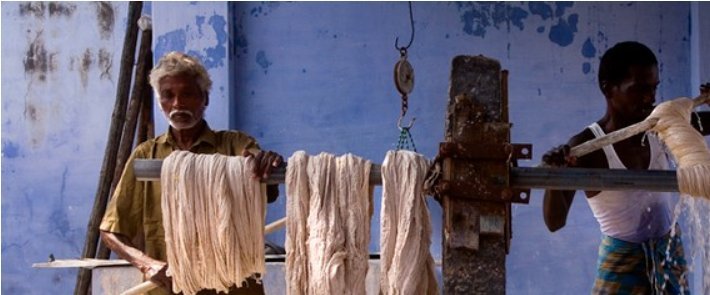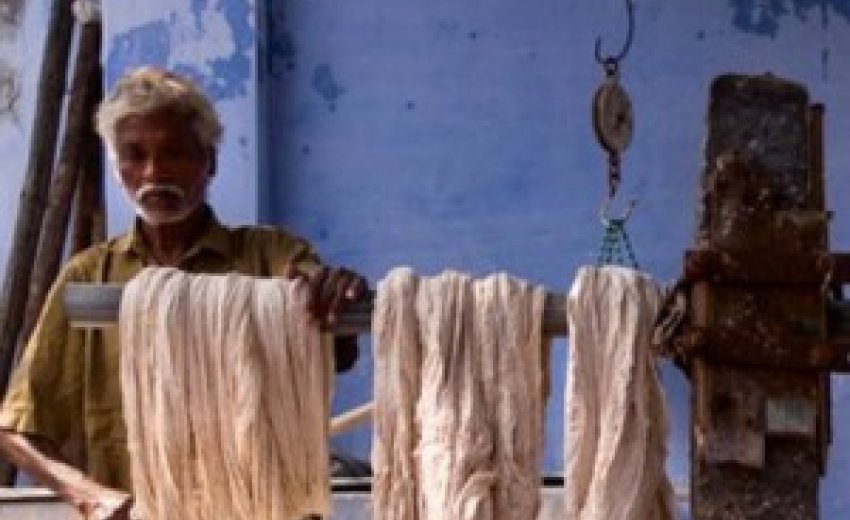| GoSikh.com December Newsletter Dec. 09, 2014 |
  |
 |
| The Image above is of men dyeing cotton (copyleft wikipedia) |
WaheGuru Ji Ka Khalsa WaheGuru Ji Ki Fateh
I am writing to you from New York, Long Island to be exact. I am here visiting family and friends. it seems one week is very little time to spend with friends, let alone with family.
|
|
| Color is an important aspect of human world. We like to wear clothes of all kinds of colors
and hues, eat food decorated with colors, even our medicine
s are colorful. No wonder then,
that a lot of research has gone into the production of color. Today there are more than ten
thousand dyes available commercially and seven lakh tons of dyes are produced annually
(Zolinger, 1987). Dyes can be of many differe
nt structural varieties like acidic, basic,
disperse, azo, anthraquinone based and metal complex dyes among others. The textile
industry is the largest consumer of dye stuffs. During the coloration process a large
percentage of the synthetic dye does not b
ind and is lost to the waste stream (Weber &
Adams, 1995). Approximately 10-15% dyes are released into the environment during dyeing
process making the effluent highly colored and aesthetically unpleasant. The effluent from
textile industries thus carries
a large number of dyes and other additives which are added
during the colouring process (Wang et. al., 2002). Thus dyes are a potential hazard to living organisms. It is hence important to safeguard the environment from such contaminants. ....Source |
There is one thing that bothers me and it is tough for me to enjoy my stipend (not salary) from GoSikh. It is tough for me to enjoy our accolades and thanks. The issue at hand is POLLUTION.
Yes, pollution.
There are 2 active issues at hand:
- The environmental impact of producing the Turbans (and that includes all clothes from India). We will discuss this issue today.
- The environmental impact of getting the Turbans to you. We are reducing this impact by creating shipping centers in Europe and Asia. We have started with Dublin, Ireland, thanks to New to Sikhi team.
Lets start with Cotton, the primary raw material used in making turbans, patkas, other clothings we use as Sikhs. Sources (vary) state that it takes anywhere from 700-2700 litres of water to grow enough cotton to make one t-shirt. I want to assume that it takes about the same amount of cotton to make one Turban.
On top of the high water footprint of Cotton, Cotton plants account for more than 10% of total pesticide use and nearly 25% of insecticides use worldwide, source and here is another article
Once we have cotton, we dye the cotton used in Turbans and Patkas to cool colors like green, pink, orange, purple, blue and the list goes on and on.The Dyeing process can cause 3 types of environmental pollution:
- The amount of water used for dyeing.
- The chemicals used for dyeing, it's pollution and human impact. Natural dyes used does not guarantee non-pollution of water.
- The waste water from the dyeing process and it's impact on water supply.
It is fair to estimate that 70% of world's clothing is made in China and India, these countries lack the manufacturing maturity needed to safely produce clothing. An article that talks about dyeing process.
 There are hundreds of sources for articles and data about pollution caused by dyeing.
There are hundreds of sources for articles and data about pollution caused by dyeing.
Sikhs CANNOT stop using Turbans/Patkas. Soooo, what is the solution?
Here are a few:
- Make your Turbans last longer, yes, that means we buy fewer Turbans.
- Help move the dyeing industry to use less water.
- Help move the dyeing industry to less abrasive and non-toxic dyes.
This might lead to loss of some colors and
GoSikh.com is OK with eliminating the colors that take a lot more water and dyes. - Move the dyeing upstream to the yarn making process, something that is being done in small scale.
- Use Natural color Turbans and natural dyes. This is something we will focus on in 2015.
Our promise:
We at GoSikh.com will do our part in reducing our enviromental impact. We will do our best to
use natural turbans and natural dyes, you will see this happen as early as early 2015.
We don't want you to stop wearing a Turban/Dastaar/Dumalla, really please don't stop.
We don't want you to stop buying turbans :-P
We hope you will support Natural Cotton Turbans, ones that have not been dyed or bleached.
We hope you will support Natural Cotton Turbans that have been dyed using natural dyes.
Christmas, Hannukah, Kwanzaa, Gurpurab is close. We wish you and your family the best. I hope you will donate a few dollars to your nearest food bank. $5 donated to a food bank will go a loooong ways.
I want to take this time and thank you all for a wonderful 2014. Thanks for giving us a chance to
serve and we look forward to being of service in 2015. We hope you will share us with a friend or ten ;-).
Chardi Kala
Guri Singh
www.goSikh.com
www.loveyourturban.com
www.stikhs.com
e: [email protected] (works best, we check this all the time)
instagram facebook twitter
